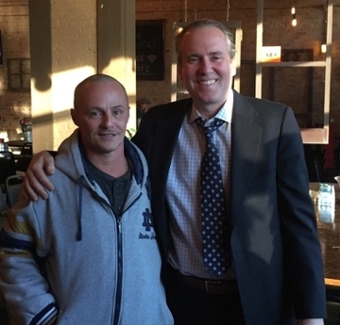Raymond McCann II

Ray McCann II and Greg Swygert
On December 7, 2017, St. Joseph County, Michigan Circuit Court Judge Paul E. Stutesman signed an order today granting Raymond McCann II’s motion to vacate his 2015 perjury conviction. The motion was filed by the Center on Wrongful Convictions at Northwestern Pritzker School of Law and the Michigan Innocence Clinic at the University of Michigan Law School, and was joined by St. Joseph County Prosecutor John McDonough, who stipulated that the motion should be granted and the charges dropped.
McCann’s exoneration marks the end of a nightmare that began on November 8, 2007, when 11-year-old Jodi Parrack was reported missing in the small town of Constantine, Michigan. McCann, a reserve police officer, agreed to help participate in the search. He became a “person of interest” after he was one of several people to suggest searching the local cemetery. Parrack’s body was found there a short time later. Police continued to pursue McCann aggressively for years even though DNA evidence found on the victim did not match McCann.
Constantine police officers and detectives from a Michigan State Police task force questioned McCann nearly two dozen times over nearly five years after Parrack’s body was discovered. A Michigan State Police detective falsely told McCann they had evidence tying him to the murder—including that McCann’s DNA was on Parrack’s body and Parrack’s DNA was in McCann’s truck. The detective also told lies about McCann to his family members and friends, going so far as to tell McCann’s teenage son that McCann was a drug addict, in an apparent attempt to turn his family and friends against him and get McCann to confess. Despite intense pressure, McCann insisted he was innocent.
In 2012, with the investigation going cold, the Michigan State Police detective told one of McCann’s relatives that he wanted to see McCann locked up to increase the pressure on him to confess. The detective then persuaded the county prosecutor to issue a subpoena to require McCann to testify under oath concerning his whereabouts at the time of Parrack’s disappearance. In 2014, the prosecutor then charged McCann with perjury during a murder investigation, which carries a life sentence. All of the charges stemmed from minor discrepancies between McCann’s recall of the events surrounding Parrack’s disappearance five years earlier and the recollections of others.
One of the perjury counts stemmed from McCann’s testimony that he had searched for Parrack at the Tumble Dam, a ruin where Constantine kids often hung out. McCann said under oath that he had parked at the trailhead and was prepared to search for Parrack there when he got a call and went elsewhere. The Michigan State Police detective testified under oath that video footage from a surveillance camera on a nearby factory proved McCann was never there that night.
After spending 11 months in jail awaiting trial and facing a potential life sentence, McCann pleaded no contest to the count involving the Tumble Dam, believing he had no chance of acquittal if there was a video that contradicted his recollection, especially in a community convinced he had murdered Jodi Parrack. He was sentenced to 20 months in prison in 2015.
While McCann was in prison, a man named Daniel Furlong attempted to abduct another young girl in nearby White Pigeon, Michigan. The girl got away and led authorities back to Daniel Furlong. Furlong, who lived in Constantine at the time of Parrack’s murder, eventually admitted killing Parrack eight years earlier, and a subsequent DNA test on Furlong matched DNA found on Parrack. Under interrogation, Furlong insisted he did not know McCann and told the authorities that when he learned that McCann had been arrested, he believed “he was in the clear.”
After McCann was paroled from prison, Ken Kolker, a television reporter from WOODTV in Grand Rapids, contacted CWC attorney Steven Drizin and asked him to evaluate the interrogations of McCann. “This was one of the worst cases of police tunnelvision I’ve ever seen,” said Drizin. In fact, even after Furlong was identified by DNA evidence as the killer, the authorities went to McCann’s prison and tried to pressure him into admitting that he and Furlong were accomplices. Again, McCann refused to falsely confess to knowing Furlong.
Drizin recruited his CWC colleagues Greg Swygert and Megan Crane, students Courtney Cronin and Caroline McMahon, David Moran, Director of the Michigan Innocence Clinic, to work on the case. In March 2016, lawyers and students from both projects launched a re-investigation in the case.
The Michigan students made two important discoveries that established there was no video evidence proving McCann had lied under oath about driving to the Tumble Dam. First, the students established that darkness made it impossible to tell whether McCann’s car or any other specific cars were in the area near the Tumble Dam path. Second, further investigation and a closer look at the video revealed that video camera could not have captured McCann’s car because the cameras were not facing the direction of the path to the Tumble Dam. These discoveries made it clear that the Michigan State Police detective, who had accused McCann of lying, had testified falsely about the video to Prosecutor McDonough.
This case was the CWC's third partnership with the Michigan Innocence Clinic, all of which resulted in exonerations. For more background information about the case, see Ken Kolker’s “Making a Monster” on WOODTV.

